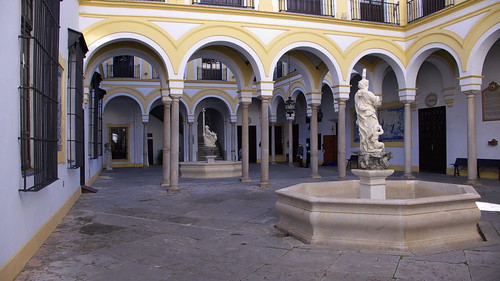
If you were to enter the Church of San Jorge, Hermandad de la Caridad in Seville, the spectacle of death would be all around you. Valdes Leal's In Ictu Oculi and Finis Gloriae Mundi emerge from the dimness, with Pedro Roldan's and Murillo's sculpture of the Entombment of Christ directly ahead, on the high altar, surrounded by Bernardo Simon de Pineda's retablo covering the apse wall. It's crowned by the three cardinal virtues: Faith, Hope and Charity, which are echoed throughout the church's decorative scheme. The altar is the culmination of Murillo's Six Acts of Mercy, as well as showing the founding charity of the Caridad: burial of the dead. This sculpture also shows the promised reward of resurrection and salvation. The worshipper passes from life outside the church, through death (in Valdes Leal's pictures) and on to the blessed life beyond (seen in the high altar). Murillo's six paintings of charitable acts, as well as showing the Brotherhood's primary concerns, are the suggested means of obtaining the final goal of salvation. His St John of God and St Elizabeth of Hungary bring these depicted acts of charity down to earth.
But why this concern with death and charity throughout the church?
In late fifteenth century Spain, men hung by gallows were required by law to remaining hanging for a week after death. Their corpses inevitably fell to the ground during this time, where scavenging animals came to eat them. Legend has it that to allay this horrible custom, Pedro Martinez, an honorary canon of Seville Cathedral, built a wall around the gallows and consecrated the ground within as a cemetery. After the deceased had hung for a week, he carried out a proper funeral and burial.
When Martinez himself died, he bequeathed his money for the upkeep of this practice. It wasn't, however, until at least 1565 that the money was received. By then, a hundred and twenty men had joined together as The Caridad, with the mutual intent of burying the dead. This answered an urgent social need, for it was common in Spain in those days to see the dead victims of starvation, exposure and assault lying around, unburied. The Caridad flourished for over twenty years, and in 1578 the Brotherhood rented the Church of San Jorge from Philip II.
A decade later it was declining, and this low period lasted for about sixty years. The church, always prone to flood damage, fell into bad disrepair, and between 1613 and 1640 there were only twenty nine new members - an average of about one new member a year. But, this decline did not bring the good work to an end.
A series of natural disasters resulted in the revival of the Caridad, which was suddenly faced with having to cope with a heightened rate of mortality. In 1649 a plague reached Seville, having ravaged its way from the east coast leaving ghost towns in its path. A subsequent lack of farm workers to tend crops led to a famine in 1651 caused the death by starvation to hundreds. During the painful years between 1650 - 1653, a hundred and eighteen new members joined the Brotherhood which thus became stronger and more active.
The Caridad grew both in size and importance and in 1661 a new Regla for the charity was drawn up. The following year Mighuel Manara, the man behind the decoration of the church, joined the brotherhood. In 1663 he became leader, and his rule endured until his death sixteen years later in 1679. With the installation of Manara as the leader of the Brotherhood, four new charities became affiliated to the existing charitable burials. The aim of these new tasks was to reduce the number of burials. They set up a hospice in a warehouse rented from the Royal Arsenal, to shelter and feed the homeless and hungry. An ambulance service and the visitation of the sick were instituted, and an infirmary was established to care for the aged and terminally ill. Finally, Manara planned to educate the patients in the Christian faith, an aim which is well reflected in the church's decorative scheme. It was this church which was Manara'a priority and, after a few complications, its renovation was complete by July 1670.

No comments:
Post a Comment